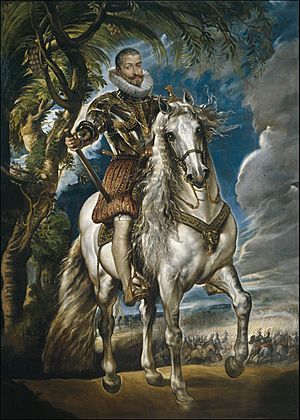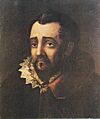Francisco de Sandoval y Rojas, 1st Duke of Lerma facts for kids
Quick facts for kids His EminenceThe Most Excellent The Duke of Lerma |
|
|---|---|
| Cardinal-priest of San Sisto | |

Francisco Goméz de Sandoval y Rojas, Duke of Lerma, Spanish statesman, by Peter Paul Rubens (1603). Located in the Prado.
|
|
| Enthroned | March 1621 |
| Reign ended | 17 May 1625 |
| Predecessor | Giambattista Leni |
| Successor | Laudivio Zacchia |
| Orders | |
| Ordination | March 1622 |
| Created Cardinal | 26 March 1618 |
| Rank | Cardinal-priest |
| Personal details | |
| Born | 1552 Tordesillas, Castile and León, Spain |
| Died | 17 May 1625 (aged 72) Valladolid, Castile and León, Spain |
| Nationality | Spanish |
| Denomination | Roman Catholic |
| Previous post | Valido of the Spanish Empire |
Francisco Gómez de Sandoval y Rojas, 1st Duke of Lerma (born around 1552 or 1553 – died May 17, 1625), was a very powerful person in Spain during the reign of Philip III of Spain. He was the first of the "validos," which means "most worthy" or "favorite." These were powerful ministers who practically ruled for the later Habsburg kings of Spain.
Contents
Becoming a Powerful Duke
Francisco de Sandoval was born in 1552. His father was the Count of Lerma and Marquis of Denia. His mother was Isabelle de Borgia. The Sandoval family was very old and important.
Life Before Power
Francisco grew up in Tordesillas, Spain. When King Philip II was alive, nobles like Francisco didn't have much say in how the government was run. They mostly served as courtiers. Francisco spent his time at court and became a close friend and favorite of the young Prince Philip, who would later become King Philip III.
Rise to Power with Philip III
When Philip III became king, he quickly gave all his power to Francisco. Francisco became incredibly influential, acting as the king's "shadow." This meant all important information and decisions went through him first. In 1599, King Philip III made him the Duke of Lerma. The king also helped Lerma's uncle become a cardinal and gave Lerma control over many public offices and lands.
Lerma also received many gifts from important people outside the royal court. For example, the Medici family from Florence sent him a large marble statue. He also collected many paintings, including one by Fra Angelico that is now in the Prado Museum in Madrid.
Leading Spain's Foreign Policy
As the chief minister, Lerma had strong ideas about how Spain should deal with other countries. He wanted to strengthen Spain's rule by arranging many marriages between the Spanish royal family and other powerful European families, like the Austrian Habsburgs and the French Bourbons.
Peace and Conflict
Lerma's time in power started with a peace treaty with France in 1598, called the Treaty of Vervins. However, Spain continued to fight costly wars with England until 1604, when Spain was too tired to continue and made peace. Lerma also tried to prevent the Low Countries (modern-day Netherlands and Belgium) from becoming independent from Spain.
Expulsion of the Moriscos
Even though Spain's government was almost bankrupt in 1607, Lerma made a very controversial decision. From 1609 to 1614, he ordered the expulsion of the Moriscos. These were Moors (people of Muslim heritage) who had converted to Christianity. Over 300,000 people were forced to leave Spain. This decision was based on religious and political reasons, not economic ones. It made the clergy and many ordinary people happy. It also brought some money to the royal treasury from the properties of the expelled Moors. However, it severely damaged the economy of regions like Valencia for many years.
Financial Challenges
Lerma's ideas about money were quite old-fashioned for his time. His main ways of dealing with financial problems were to reduce the value of coins and to issue rules against luxury items. The war with the Dutch continued until 1609, when a Twelve Years' Truce was signed. There was also ongoing unrest in Portugal, which had been part of Spain since 1580.
Fall from Power
In the end, Lerma lost his position because of a plot by his own son, Cristóbal de Sandoval, the Duke of Uceda. His son was influenced by Olivares, who would later become a powerful minister himself. King Philip III likely trusted Lerma until the very end.
On October 4, 1618, Lerma was forced to leave the royal court. To protect himself and keep some power, he had convinced Pope Paul V to make him a cardinal in March 1618. This gave him special protection from legal action.
Life After the Court
Lerma retired to his palace in Lerma, and then to Valladolid. It was said that he attended Mass every day with great devotion. When King Philip III was dying, he forgave many prisoners and exiles, but not Lerma.
After Philip III died, Lerma was ordered by Olivares to live in Tordesillas. However, Lerma did not obey and asked the Pope for help. The Pope and other cardinals supported him, seeing his banishment as an attack on the church's freedom.
Under the new king, Philip IV, who began his rule in 1621, Lerma lost much of his wealth. In 1624, he was ordered to return a large sum of money to the state. Lerma died in 1625 in Valladolid.
Family Life
The Duke of Lerma married Catalina de la Cerda in 1576. They had five children:
- Cristóbal de Sandoval, Duke of Uceda (1577 - 1624), who took over his title.
- Diego de Sandoval (died 1632).
- Juana de Sandoval (died 1624). Her daughter, Luisa de Guzmán, later married the Duke of Braganza, who became King John IV of Portugal.
- Catalina de Sandoval (died 1648).
- Francisca de Sandoval (died 1663).
Building Projects

Lerma was known for spending a lot of money, even when the country was struggling financially. He built a grand palace in the village of Lerma (from 1606 to 1617). This palace had towers, a large courtyard, and was connected by a private walkway to the church of San Pedro. Lerma was also very religious and spent a lot on religious buildings.
In Popular Culture
The Russian poet Mikhail Lermontov (1814-1841) believed his family name was linked to the Duke of Lerma's title. He even painted a picture of an imaginary "Duke of Lerma" and wrote other works about Spanish characters.
See also
 In Spanish: Francisco de Sandoval y Rojas, I duque de Lerma para niños
In Spanish: Francisco de Sandoval y Rojas, I duque de Lerma para niños
- Lerma, Burgos
- The Great Favourite
Images for kids
-
Fictional "Duke of Lerma", painting by Mikhail Lermontov



